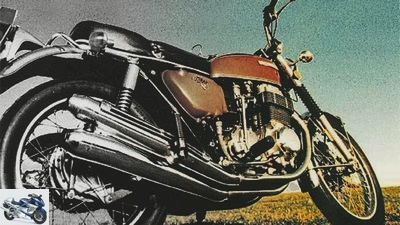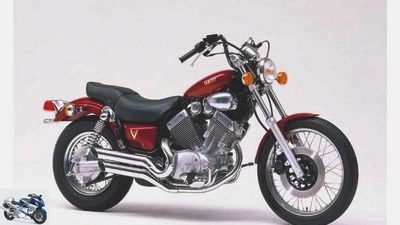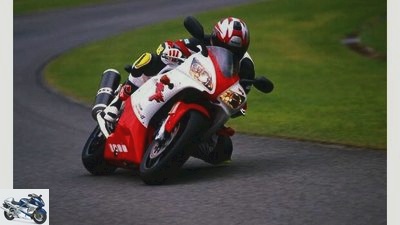Table of contents
- Motorcycle review in decades Motorcycles that shaped epochs
- 1968 to 1978
- From 1988 to the present
- That happened in 1968
- That happened in 1978
- That happened in 1988
- That happened in 1998

archive
motorcycles
Motorcycle review in decades
Motorcycle review in decades
Motorcycles that shaped epochs
New year, time to look back. But not primarily for 2008. But for the motorcycles that you can still remember after ten, 20 or even 40 years. What moved us in 1968 or 1978, what fascinated us in 1988 or 1998?? What was the future like back then?
December 18, 2008
Mass protests by schoolchildren and students in 1968 called the bourgeois norms of Western societies into question: They were directed against the Vietnam War, downplaying the unprecedented Nazi crimes and the conservative mustiness of the years of construction. But while in San Francisco the “Flower power”
Movement arose, in Berlin the water cannons dried up and in Paris the burning barricades gradually smoldered, another revolutionary movement began: that of a motorcycle, born out of pure passion, no longer a weather-dependent means of transport.
The Honda CB 750 Four hit like a bomb 40 years ago? in the year in which Andreas Baader and Gudrun Ensslin detonated their first explosive device. From now on, the two-wheeler became a joyfully celebrated leisure device. Monstrous! Because from the mid-1950s onwards nobody in the Federal Republic wanted to have motorcycles. Those who could afford it had switched to a car. Within twelve years, from 1956 to 1968, the number of motorcycles fell by a tenth, from 2.5 million to 250,000 machines. It seemed only a matter of time before the last motorcycle would rust to itself in some nameless garage.
And now that: four cylinders, 67 hp, Vmax allegedly 190, disc brakes, four shiny, proudly chrome-plated exhaust pipes. All attention. Honda only existed since 1948. In 1958, the company celebrated the ten millionth two-wheeler and rammed an important milestone into the ground: The Honda Super Cub model made its debut “Cheap urban bike”, a cheap vehicle for mass motorization. To date, 60 million units have rolled off the production line; it is the most frequently built motor vehicle in the world. But the CB 750 developed a different dynamic, a new form of explosive power. Because it inspired dreams, unleashed imagination, aroused desire. It became the successful savior of the idle motorcycle scene around the world.
1968 to 1978

Yamaha XV 535 Virago: Absolute favorite of the Germans with 51 621 machines sold
It was as if an alien had landed 40 years ago. What a step forward: In MOTORRAD 15/1968 the editors had celebrated two thirds more performance within a ten-year period: “In 1958, a four-stroke engine with 18 hp from 250 cm3 was considered to be absolutely sporty, i.e. 72 hp / liter displacement. In 1968 the modern Japanese high-performance 250s offer 30 hp, i.e. 120 hp / liter displacement.” Now people are talking about three times the displacement and more than double the power with the 750. The world, it was no longer the same.
Ten years later, all manufacturers set off a veritable firework of models. As between the superpowers USA and the Soviet Union, the arms race was in full swing among motorcycle manufacturers. Yamaha launched the 95 hp, cardan-reinforced and super-heavy XS 1100. At the same time, Yamaha marked the other extreme: the SR 500 as a rediscovery of the classic street single cylinder “back to the roots”. Suzuki countered with the GS 1000 as the last of all Japanese thousands.
BMW relied on pampering comfort and brought the R 100 RT. A model followed by a series that has now been produced continuously for 30 years. A unique record among large motorcycles. But in 1978, Honda again set the superlative. It is true that Benelli had already established the in-line six-cylinder in series in the form of the Sei with 750 and 900 cm3 displacement. But the 1000 cc, 105 hp CBX broke all conventions. At the same time, the CX 500 appeared as a good, robust workhorse. At the end of 1978, Honda followed suit with the CB 900 F Bol d? Or, the most successful superbike of the late 70s and early 80s.
From 1988 to the present

Yamaha’s R1: More powerful and uncompromising than any other road machine before
Ten years later, in 1988, Honda launched its indestructible 52-degree V2, which made its debut in parallel in the VT 600 C, NTV 650 and the XRV 650 Africa Twin. Their wild but stylish war paint has long been just as legendary as their unconditional suitability for long-distance travel. A great kit! In addition, one of the most characterful and speediest athletes saw the light of day in 1988: the V4-equipped VFR 750 R, still better known today under its abbreviation “RC 30”. Helmut Dahne drove his famous record lap on the Nordschleife with the perfectly balanced, timelessly young-at-heart RC 30.
Harley-Davidson brought out the 1200 Sportster in 1988 and Yamaha brought out the XV 535 Virago to Germany for the first time. It rose to become the best-selling motorcycle in Germany. At the same time, Kawasaki presented the first ZX-10. With it, Kawa continued the tradition of the Z 900 and Z 1000 power bikes. With the K1, BMW pushed the plastic-clad, candy-colored age to the extreme, which Honda had founded with the CBR 600 and CBR 1000. BMW mechanics hated the extremely built-in K1 and allegedly fled in all directions as soon as one came into the workshop. The largest single-cylinder in the world, the Suzuki DR 750 Big, remained more down-to-earth.
In 1998, the Yamaha R1, MV Agusta F4 and Aprilia RSV will usher in the super sports era. The Yamaha FZS 600 Fazer establishes a new, attractive and active middle class. And which machines from 2008/2009 will be the classics of the future? The Ducati Desmosedici RR, the first MotoGP offshoot available for sale? Or the completely renovated Monster series? Do the KTM RC8 and BMW HP2 mark a turning point? Wrong: Buell installs water-cooled Rotax engines.
What will provide the impetus? The fully automatic Aprilia NA 850 Mana or the first electric motorcycles like the Enduro Quantya? The new Yamaha Vmax breaks the 200 HP sound barrier, Aprilia is building a completely new V4 sports car. Will they be milestones? At the other end of the two-wheeler scale, things come full circle: after 50 years, Honda is bringing an offshoot of the Super Cub to Germany, the Innova 125. The future, it knocked hard on our door. Who knows, maybe this is the motorcycle ?? as we know it today? yes, in 30 or 40 years only history. But nice memories and many great experiences will remain with us in the future.
That happened in 1968
International protest
Martin Luther King and Robert Kennedy are murdered in the USA, and Rudi Dutschke is shot in Berlin. Student protests in Paris are rampant, and the “68ers” are rebelling in West Germany and Czechoslovakia. In this country they meet hundreds of police, the? Prague Spring ?? ends bloody under curb chains.
New ideas fit into troubled times
The Honda CB 750 perfectly embodies the dawn of a new era. Photos of the fully wired Erlkonig appear for the first time in MOTORRAD 22/1968. Since then, the four-cylinder with the four exhaust pipes and the first series disc brake has moved motorcyclists tremendously.
From twin to triple
At the end of 1968, Triumph presented the Trident 750 with a 60 hp three-cylinder. There is no sign of the current success of the concept, in 1975 the triple production ends for the time being.
That happened in 1978
There has never been more variety!
While the industry is bringing every imaginable motorcycle concept into series production, the republic is recovering from the terror of the “German Autumn”. 1977. Sigmund Jahn is the first German to fly into space for the GDR. John Paul II becomes Pope, the third in 1978. The first GPS satellite goes into space and a legend at Christmas: the first Paris-Dakar rally.
From ugly duckling to proud swan
The CX 500 quickly became a top seller, around 20,000 units still exist today. The modern V2 all-rounder has water cooling, four valves per cylinder, double disc brake at the front and cardan shaft. Versions with 650 cc, the first turbo-charging and the nickname “slurry pump” followed later …
Gigantomy now has a name
The Honda CBX with a six-cylinder in-line engine was the sensation of the 1978 season. The 1000’s mighty 105 hp and its unstable driving behavior sparked a debate about manageable maximum performance; In 1979, manufacturers and importers voluntarily restricted themselves to 100 hp in Germany.
Travel dreams ex works
RT models have been rolling off the assembly line in uninterrupted succession for 30 years, almost a quarter of a million so far. Its equipment was specified by the 70 hp R 100 RT as early as 1978: full fairing, cardan shaft, case.
That happened in 1988
The unthinkable becomes real
Michael Gorbachev withdraws the Red Army from Afghanistan, the USA and the USSR decide to dismantle all nuclear medium-range missiles. The police and the media fail in the hostage drama in Gladbeck. Air disasters hit Ramstein, Remscheid and Lockerbie.
Absolute Virago hit
The Yamaha XV 535 becomes the most popular motorcycle in Germany. The soft chopper has found its fans 51621 times.
New technology at Ducati
As early as 1986, water cooling and four-valve heads found their way into the filigree tubular space frame, initially in the factory racer 748. This is followed by the commercially available 851 series offshoot. It is the legitimate ancestor of 1098 and 1198.
Enduros of a different caliber
The fattest series single of all time drives the Suzuki DR Big 750. But despite the later increase in displacement to 800 cm³, the platypus will never be as legendary as the Honda Africa Twin from the same year. Its nimbus is still valid today, regardless of whether it is 650 or 750 cm³.
That happened in 1998
Lived utopias
While still in Bonn, Gerhard Schroder becomes Chancellor of the first red-green federal government. This ended the Kohl era after 16 long years. The Red Army Faction (RAF) announces its dissolution. With great fanfare, Daimler-Benz and Chrysler merge to form the world’s third largest automaker. Avian flu breaks out in Hong Kong and the alleged child murderer Marc Dutroux in Belgium.
Competition for Ducati
South of the Alps, Aprilia goes all out. The RSV mille combines Japanese performance with Italian style. Rotax delivers the 128 hp V2 with an unconventional 60 degree cylinder angle. Aprilia’s first multi-cylinder model shines right from the start with great sportiness and reliability. Al dente, the mille.
Drifted away
While most Japanese choppers and cruisers are copying from Harley, Kawasaki is going a different way, using historical Indian types as models. Nevertheless, the Drifters 800 and 1500 flop (photo). Fully clad wheels under huge plastic covers find few fans.
?? sex on wheels ??
When MV Agusta unveiled the F4 for the first time at the end of 1997, the sensual shapes of the 750s seduced en masse. But their lovers need patience: The sinfully expensive copies of the ?? series Oro ?? are not allocated until 1999. In terms of sport, the MV remains in a narrow niche.
Related articles
-
Top 20 new motorcycle registrations women 1st half of 2018
manufacturer 20th pictures manufacturer 1/20 20th place among new motorcycle registrations for women in the first half of 2018: Honda CBR 500 R with 69…
-
Japan – a motorcycle manufacturing nation
MOTORCYCLE 15th pictures MOTORCYCLE 1/15 Japan’s motorcycle builder Honda 2/15 Like on the assembly line? In Japan – as here at Honda with the Africa…
-
New motorcycle registrations in Europe 2020 in plus
Arturo Rivas 50 pictures BMW 1/50 First place among new motorcycle registrations in 2020: BMW R 1250 GS with 9,228 units. Commercial registrations:…
-
Portrait of Jan Leek – the motorcycle cosmopolitan
Blacksmith 6th pictures archive 1/6 Jan Leek in portrait. Blacksmith 2/6 Jan Leek in portrait. Blacksmith 3/6 Jan Leek in portrait. Rivas 4/6 Jan Leek in…
-
NSU / Audi 11 pictures simplicissimus.info 1/11 The history of the motorcycle began around 1900. BMW 2/11 In the deepest valley of the motorcycle…
-
Gargolov Sports & scene Life: Annual Review 2013 Annual review That was 2013 BMW celebrated its 90th anniversary, MOTORRAD turned 110! But there was also…
-
Quail Motorcycle Gathering in Carmel California
Blacksmith Sports & scene Events Quail Motorcycle Gathering in Carmel / California Life: Quail Motorcycle Gathering Vanities Fair At the Quail Motorcycle…
-
Spotlight on motorcycle production, part 3: BMW
Bilski 13th pictures Bilski 1/13 A location with tradition – the oldest halls of the Spandau plant have been in existence since 1928, and since 1939 it…
-
Edge motorcycles Motorcycle market in china Motorcycle market in china Mass mobilization The Chinese motorcycle market seems inexhaustible, but only for…
-
Legendary riders from motorcycle racing
ADAC 14th pictures archive 1/14 Start of the German Grand Prix in Hockenheim 1985 in front of full ranks. archive 2/14 The most famous black line in the…